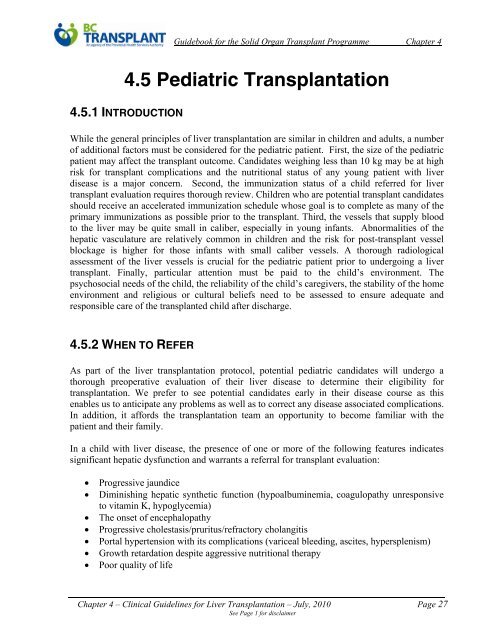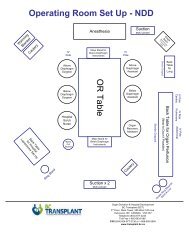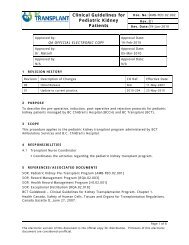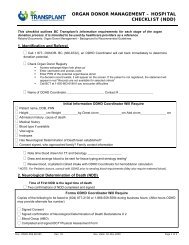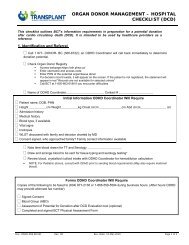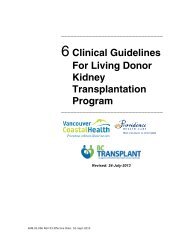4. Clinical Guidelines for Liver Transplantation (PDF) - British ...
4. Clinical Guidelines for Liver Transplantation (PDF) - British ...
4. Clinical Guidelines for Liver Transplantation (PDF) - British ...
You also want an ePaper? Increase the reach of your titles
YUMPU automatically turns print PDFs into web optimized ePapers that Google loves.
Guidebook <strong>for</strong> the Solid Organ Transplant Programme Chapter 4<br />
<strong>4.</strong>5 Pediatric <strong>Transplantation</strong><br />
<strong>4.</strong>5.1 INTRODUCTION<br />
While the general principles of liver transplantation are similar in children and adults, a number<br />
of additional factors must be considered <strong>for</strong> the pediatric patient. First, the size of the pediatric<br />
patient may affect the transplant outcome. Candidates weighing less than 10 kg may be at high<br />
risk <strong>for</strong> transplant complications and the nutritional status of any young patient with liver<br />
disease is a major concern. Second, the immunization status of a child referred <strong>for</strong> liver<br />
transplant evaluation requires thorough review. Children who are potential transplant candidates<br />
should receive an accelerated immunization schedule whose goal is to complete as many of the<br />
primary immunizations as possible prior to the transplant. Third, the vessels that supply blood<br />
to the liver may be quite small in caliber, especially in young infants. Abnormalities of the<br />
hepatic vasculature are relatively common in children and the risk <strong>for</strong> post-transplant vessel<br />
blockage is higher <strong>for</strong> those infants with small caliber vessels. A thorough radiological<br />
assessment of the liver vessels is crucial <strong>for</strong> the pediatric patient prior to undergoing a liver<br />
transplant. Finally, particular attention must be paid to the child’s environment. The<br />
psychosocial needs of the child, the reliability of the child’s caregivers, the stability of the home<br />
environment and religious or cultural beliefs need to be assessed to ensure adequate and<br />
responsible care of the transplanted child after discharge.<br />
<strong>4.</strong>5.2 WHEN TO REFER<br />
As part of the liver transplantation protocol, potential pediatric candidates will undergo a<br />
thorough preoperative evaluation of their liver disease to determine their eligibility <strong>for</strong><br />
transplantation. We prefer to see potential candidates early in their disease course as this<br />
enables us to anticipate any problems as well as to correct any disease associated complications.<br />
In addition, it af<strong>for</strong>ds the transplantation team an opportunity to become familiar with the<br />
patient and their family.<br />
In a child with liver disease, the presence of one or more of the following features indicates<br />
significant hepatic dysfunction and warrants a referral <strong>for</strong> transplant evaluation:<br />
<br />
<br />
<br />
<br />
<br />
<br />
<br />
Progressive jaundice<br />
Diminishing hepatic synthetic function (hypoalbuminemia, coagulopathy unresponsive<br />
to vitamin K, hypoglycemia)<br />
The onset of encephalopathy<br />
Progressive cholestasis/pruritus/refractory cholangitis<br />
Portal hypertension with its complications (variceal bleeding, ascites, hypersplenism)<br />
Growth retardation despite aggressive nutritional therapy<br />
Poor quality of life<br />
Chapter 4 – <strong>Clinical</strong> <strong>Guidelines</strong> <strong>for</strong> <strong>Liver</strong> <strong>Transplantation</strong> – July, 2010 Page 27<br />
See Page 1 <strong>for</strong> disclaimer


